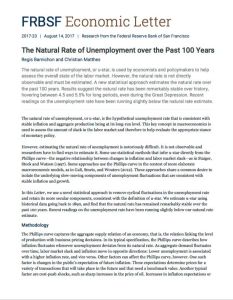Join getAbstract to access the summary!

Join getAbstract to access the summary!
Regis Barnichon and Christian Matthes
The Natural Rate of Unemployment over the Past 100 Years
FRBSF, 2017
What's inside?
The natural rate of unemployment is a barometer of a stable economy.
Recommendation
Economists are now studying whether the US economy has reached its natural rate of unemployment, or “u-star,” signaling the equilibrium of price and output in the long run. An unemployment rate below u-star may signal an overheating economy, while joblessness at a level higher than u-star could suggest labor market weakness. Researchers Regis Barnichon and Christian Matthes offer a robust alternative for estimating u-star, which currently points to a tightening labor market. getAbstract suggests this esoteric study to economists and analysts.
Summary
About the Authors
Regis Barnichon is a research adviser at the Federal Reserve Bank of San Francisco, and Christian Matthes is a senior economist at the Federal Reserve Bank of Richmond.
















Comment on this summary